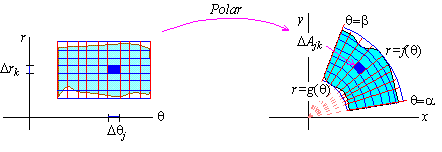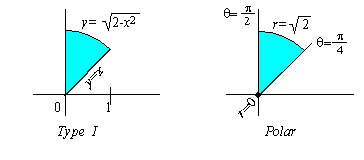Part 1: Change of Variable into Polar Coordinates
We can also apply the change of variable formula to the polar
coordinate transformation
|
x = rcos( q) , y = rsin( q) |
|
However, due to the importance of polar coordinates, we derive its change of
variable formula more rigorously.
To begin with, the Jacobian determinant is
|
|
¶( x,y)
¶( r,q)
|
= |
ê
ê
ê
|
|
|
ê
ê
ê
|
= rcos2( q) +rsin2( q) = r |
|
As a result, the area differential for polar coordinates is
|
dA = |
ê
ê
|
|
¶( x,y)
¶( r,q)
|
ê
ê
|
drdq = r dr dq |
|
Let us consider now the polar region S defined by
|
q = a,q = b,r = g( q) ,r = f( q) |
|
where f( q) and g( q) are contained
in [ p,q] for all q in [ a,b] .
If q0,¼,qm is an h-fine partition of [a,b] and r0,¼,rn is an h-fine partition
of [ p,q] , then the image of [ a,b]×[ p,q] is a partition of the image of the region with
near parallelograms whose areas are denoted by DAjk:

Since the area differential is dA = rdrdq, the area of the "near parallelogram" is approximately
so that if xjk = rjcos( qk) and yjk = rjsin( qk) , then
|
|
lim
h® 0
|
|
n
å
j = 1
|
|
m
å
k = 1
|
f(xjk,yjk) DAjk = |
lim
h®0
|
|
n
å
j = 1
|
|
m
å
k = 1
|
f( rjcos( qk) ,rjsin( qk) ) rjDrjDqj |
|
Writing each of these limits as double integrals results in the formula for
change of variable in polar coordinates:
 |
f( x,y) dA = |
ó
õ
|
b
a
|
|
ó
õ
|
f( q)
g(q)
|
f( rcos(q), rsin(q) ) rdrdq |
| (1) |
To aid in the use of (1), let us notice that if p is
constant, then r = p is a circle of radius p centered at the origin in the
xy-plane, while if a is constant, then q = a is a ray
at angle a beginning at the origin of the xy-plane.

Polar coordinates for the origin are r = 0 for every value of q.
EXAMPLE 1 Use (1) to evaluate
|
|
|
1
0
|
|
|
| Ö |
 |
|
| 2-x2 |
|
|
( x2+y2) dydx | |
x |
|
Solution: To do so, we transform the iterated integral into a
double integral
|
|
|
1
0
|
|
|
| Ö |
 |
|
| 2-x2 |
|
|
( x2+y2)dydx = |
 |
( x2+y2) dA | |
x |
|
where R is a sector of a circle with radius Ö2. In polar
coordinates, R is the region between r = 0 and r = Ö2 for q
in [ p/4,p/2] :

Since r2 = x2+y2, the double integral thus becomes
 |
( x2+y2) dA = |
|
p/2
p/4
|
|
|
Ö2
0
|
r2 rdrdq = |
|
p/2
p/4
|
|
|
Ö2
0
|
r3 drdq |
|
and the resulting iterated integral is then easily evaluated:
 |
( x2+y2) dA = |
|
p/2
p/4
|
|
r4
4
|
ê
ê
|
Ö2
0
|
dq = |
|
p/2
p/4
|
dq = |
p
4
|
|
|
Check your Reading: What does y = x, x > 0 correspond to in
polar coordinates?





